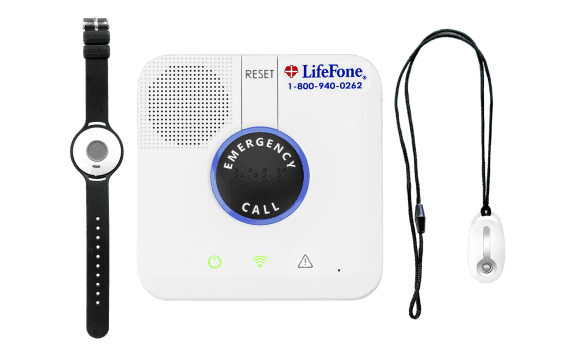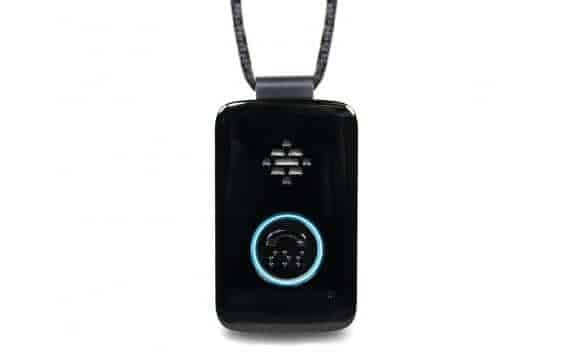LifeFone: Costs, Systems, and Plans
LifeFone’s monthly costs range from $24.95 to $47.95. After thorough testing of their equipment and monitoring services, we found that while their home and mobile systems cost slightly more than average, their $5 monthly fall detection charge (half the industry standard) provides significant value. Additionally, LifeFone requires no long-term contracts, rewards annual payments with discounted rates, and includes free spouse monitoring. Overall, while LifeFone is not the most affordable medical alert brand, they provide a fair value.
Key Findings
- LifeFone systems cost between $24.95 and $47.95 per month, and their pricing includes both monitoring and the leasing of equipment.
- While the company requires no long-term contracts, you can get a lower monthly price by paying for a full year of service in advance.
- LifeFone charges only $5 per month for fall detection, which is half the cost of most companies.
FYI: While not the most expensive company, LifeFone is far from the most affordable. To find systems from $20 per month, read our guide to this year’s best medical alert systems.
LifeFone Cost Breakdown
| In-home system (landline) | $29.95 per month |
| In-home system (cellular) | $34.95 per month |
| Mobile system | $41.95-$47.95 per month |
| Fall detection | $5 per month |
| Protection plan | $5 per month |
| Caregiver app | $8 per month |

More Affordable Options
LifeFone systems may start at $29.95 per month, but this is not the most affordable price we've seen. If you're looking for protection for $20 per month, then we recommend one of the following medical alert brands.
LifeFone Systems
LifeFone currently offers six different systems. These include two at-home options and four mobile options. I’ll discuss these LifeFone systems in detail below.

At-Home Landline
This system uses a landline to connect to emergency help. Perfect for older adults who spend the majority of their time at home, LifeFone’s At-Home Landline system includes a base unit, your choice of a help button necklace or wristband, and optional fall detection for an extra $5 each month.
At-Home Cellular
LifeFone’s At-Home Cellular System is nearly identical to its At-Home Landline system. The cellular system, however, uses AT&T’s 4G cellular network and is slightly more expensive. It also supports the fall detection add-on for an additional $5 per month.
At-Home & On-the-Go, VIPx
A mobile system, the VIPx uses a cellular connection to connect the wearer to help. Water-resistant, lightweight, and compatible with fall detection (built into the device), the VIPx is one of our favorite GPS medical alert systems. It’s also compatible with LifeFone’s caregiver app.
To learn more about this system, check out my hands-on LifeFone review.
At-Home & On-the-Go, VIP Active
Slightly more affordable than the VIPx, the VIP Active has a similar feature set: cellular connection, water resistance, and optional fall detection. Unlike the VIPx, however, this device is not compatible with the LifeFone caregiver app.
At-Home & On-the-Go, VIP flex
While the VIP flex may resemble Medical Guardian’s MGMini Lite, the VIP flex will cost slightly less, at $43.95 per month. Compare that number to the MGMini Lite’s $46.95, not to mention its additional $149.95 equipment fee. The device can be worn around the wrist or around the neck with its included attachments, and it features the option of fall detection.
At-Home & On-the-Go, Safe Watch Active
Lifefone’s medical alert watch combines the functionality of a mobile medical alert with the discreet design of a smartwatch. In addition to its medical alert features and GPS capabilities, this device also features a pedometer and a heart rate monitor.
LifeFone Systems Compared
| System | Monthly Cost | For Use | Additional Features |
|---|---|---|---|
| At-Home Landline | $29.95 | At home |
|
| At-Home Cellular | $34.95 | At home |
|
| At-Home & On-the-Go, VIPx | $43.95 | At home and on the go |
|
| At-Home & On-the-Go, VIP Active | $41.95 | At home and on the go |
|
| At-Home & On-the-Go, VIP flex | $43.95 | At home and on the go |
|
| At-Home & On-the-Go, Safe Watch Active | $47.95 | At home and on the go |
|
LifeFone Add-Ons
LifeFone offers a far larger selection of add-on services than most personal emergency response brands. Here’s an overview of some of your options:
LifeFone Add-On Services
- Activity Assurance caregiver tool: For $6 per month, At-Home Landline and At-Home Cellular users can set up Activity Assurance. With Activity Assurance, you’ll receive daily check-ins from one of the company’s monitoring centers. A specific tone is played on your base unit each day, and a representative will call to check in if you don’t press a button within 15 minutes to confirm you’re safe and at home.
- Daily check-in calls: For an additional $19 per month, you can receive a daily call from a monitoring center agent. The call is customized to fit your needs, whether it’s a brief conversation or simply a wellness check. Older adults are at a higher risk of loneliness and social isolation, issues connected to dementia, anxiety, depression, heart disease, and more.
- Location services: With location services, caregivers for On-the-Go GPS subscribers can use their mobile device to access their loved one’s GPS location via the LifeFone Caregiver Portal. This service is particularly helpful for caregivers helping individuals with memory problems or who enjoy being out and about alone.
- Fall detection: Depending on which LifeFone medical alert system you choose, fall detection can be added for $5 per month. I’m a big advocate for fall detection, especially if it costs as little as $5 a month. Each year, 3 million older adults are treated in emergency departments for fall-related injuries. Considering what a single emergency room visit can cost, $60 a year doesn’t seem so bad.
Did You Know:One study found that when older adults were given medical alert systems, they experienced less frequent admission to emergency departments and reported higher quality of life.
LifeFone Add-On Accessories
- Vanity Pendant: One of LifeFone’s newest options, the vanity pendant looks like a tiered necklace made of the finest metals. You’d never guess it was a medical alert system. This fashion statement comes at a somewhat high cost — $49.95 — but you may want to consider it if it means you’ll feel more confident wearing a medical alert.
- Hanging Master Lock Box: Designed to fit around your doorknob, the $39.95 hanging Master lockbox provides quick access to your house keys for first responders or other individuals entering your home during an emergency. Equipped with a password lock, it ensures only those who have your password can access your keys.
- LifeFone Hanging Lock Box: A $29.95 LifeFone hanging lockbox safely stores your house key so emergency services can access it with a secret code during an emergency.
- Mobile Device Charging Cradle: If you travel frequently, then you may appreciate having this convenient $39.95 extra charging cradle for your mobile system.
- Leather Carrying Case for Mobile Device: Priced at $18.95, LifeFone’s protective carrying case for the On-the-Go systems’ mobile device will keep it in the best condition possible while you aren’t wearing it.

Purchasing From LifeFone
LifeFone medical alert systems can be purchased online through the company’s website. If you have questions about your order status or which system fits you best, customer service is available by phone 24/7. You can also reach LifeFone by email for system or service needs.

LifeFone Cancellations and Refunds
To cancel your LifeFone subscription, call 1-800-940-0262 and tell the agent you are canceling your service. Since your equipment is rented, you must return it (at your own expense) to avoid further charges and receive your prorated refund.
LifeFone Warranty Policy
Every LifeFone system is backed by a 100 percent lifetime warranty for normal wear and tear, including free battery replacement. Any damage beyond normal wear and tear, such as accidents, loss, or theft, is not covered by LifeFone’s lifetime warranty. For $5 per month, the company offers a protection plan with additional equipment support. Instead of paying several hundred dollars to fix your medical alert, LifeFone’s protection plan will replace one base unit and two emergency help buttons per year.
LifeFone App
Available on LifeFone’s VIPx systems, the VIPx caregiver app allows caregivers to track a number of helpful metrics from their smartphone, including, system location, battery life, steps counted, and any times the user pressed their help button. If a loved one misplaces their system, this app can also be used to generate a sound on the VIPx, allowing you to quickly find it. This app requires an $8 monthly subscription charge.
LifeFone Monitoring
LifeFone’s subscription monitoring plans cost between $25 and $48 per month, depending on your system. Monitoring is the only recurring fee LifeFone charges unless you add accessories or services. Considered one of the best medical alerts for couples, LifeFone protects spouses at no extra cost. The free spouse coverage is an exceptional deal, since many medical alert systems charge full price to cover a second individual.
LifeFone has three monitoring centers: one primary center in White Plains, New York, and two U.S.-based backups. The company provides choices within its monitoring, such as having the monitoring center call or text your emergency contacts before requesting first responders. If you sign up for a daily check-in or your caregiver requests Activity Assurance, expect to hear from the monitoring center frequently.
Did You Know: According to Census data, among older adults, women are more likely to live alone than men. Among adults ages 75 and older, 24 percent of men lived alone while 43 percent of women lived alone.
Compare Brands
Is LifeFone Worth It?
LifeFone’s medical alert systems offer top-of-the-line monitoring options along with a wide variety of products and add-ons you can customize to fit your needs. LifeFone is one of my picks for this year’s best medical alert systems.
LifeFone is great for:
- Reasonable prices: Life Alert costs as much as $90 per month, so I appreciated that LifeFone’s most affordable systems cost less than a third of this amount. Because of this, LifeFone is one of our favorite Life Alert alternatives.
- Affordable add-ons: Accessories make a medical alert system more efficient, more aesthetically pleasing, or easier to use. Additional emergency wall buttons ensure you can always reach help during an emergency. And vanity pendants provide a stylish way to wear your safety button. LifeFone offers an abundance of unique and affordable add-ons, which make it a more enticing brand — particularly since some medical alerts, such as Lifeline, have almost none.

LifeFone is not ideal for:
- The lowest prices: While LifeFone’s prices are cheaper than some companies, they’re not quite as affordable as systems from Bay Alarm Medical and MobileHelp.
LifeFone Frequently Asked Questions
-
What if I accidentally press my help button?
If you press your emergency help button accidentally, don’t worry! The LifeFone call center does not charge for false alarms. That said, it’s important to stay on the line. Once the representative answers, explain that you pressed your button by accident and LifeFone will categorize the call as a system test.
-
Does the 30-day money-back guarantee really last 30 days?
Yes and no. To receive a full refund, you must cancel your service and return your equipment within 30 days of exactly three business days after your system is shipped. Most systems arrive within three to five business days with standard shipping, but faster shipping is available at an additional cost.
-
How do I know when my help button’s battery is low, and what should I do if it is?
Your in-home help button should last between two and five years. When your battery reaches 20 percent, LifeFone will be automatically notified and send you a new one at no cost. If you are concerned about your button’s battery life, feel free to reach out to customer service at any time.
-
How much will my equipment cost?
LifeFone does not charge equipment fees. You pay only for the monitoring service, and equipment rental is included in your monthly subscription. If your needs change over time, there are no additional fees for switching or adding features to your system. You’ll pay only for the new rate.
-
Are LifeFone’s emergency help buttons waterproof?
LifeFone’s in-home help buttons are considered waterproof, so you can wear them in the shower or bathtub or wash the dishes with them on. Your help button should never be submerged underwater, though, and they’re not built for swimming-pool use. Mobile pendants are water-resistant and safe for the shower.




